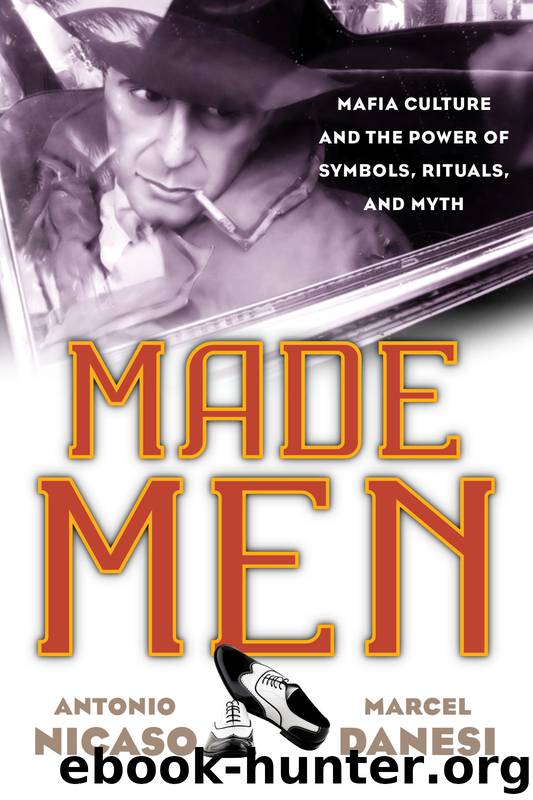Made Men by Marcel Danesi

Author:Marcel Danesi [Danesi, Marcel, Nicaso, Antonio]
Language: eng
Format: epub
Tags: undefined
Publisher: Rowman & Littlefield Publishers
Chapter 4
Appearance
Every man is the builder of a temple, called his body, to the god he worships, after a style purely his own, nor can he get off by hammering marble instead. We are all sculptors and painters, and our material is our own flesh and blood and bones.
—Henry David Thoreau (1817–1862)
As they say, appearances can be deceiving. In the case of Mafia culture, this is absolutely true. “Made men,” as the movies have certainly realized, are attractive because they literally put on appearances, from gangster chic to facial expressions meant to scare people to death. In The Godfather, Marlon Brando plays Don Vito Corleone, the capo who runs the Mafia universe from his chair. His body language, stern yet benevolent facial expression, suave clothing, and uncompromising composure in the face of adversity bespeak of an “appearance code of omertà” that, thanks to Hollywood, has become a model even for the real Mafia. Corleone is what a wise guy is imagined to be in both Mafia and popular culture. He is an icon. Like a veritable patriarch, he inspires fear, yet reassurance, by his appearance and his actions. He is even seen playing with his grandson in the movie.
The Mafioso is a chivalrous knight, a character who by force of his impeccable appearance and behavior must exude an inherent inner strength that allows him to keep up a constant “menacing atmosphere” around him. This must always be clear and unambiguous. It is imprinted in his style of clothing, his posture, his walk, and all other aspects of appearance that the made man must convey to others. Any sign of weakness is not tolerated. But are Mafiosi really like this? Photos of Mafiosi at the turn of the twentieth century hardly convey this macho image of the cool, well-dressed gangster. A lot of the actual appearance features associated with the Mafioso persona today actually come from the movies. The reality of Mafia culture today lies in the blurring of lines between fiction and reality. As filmmaker Jean Cocteau once put it, “A film is a petrified fountain of thought.”[1]
Mafiosi, like everyone else, model themselves after actors in film. The persona of the Mafioso that comes from the movies and is transferred to real life is a very attractive one, since it taps into the myth of the handsome and fearless “bad boy,” who is sexually attractive and exciting at the same time that he is dangerous. This myth is especially appealing to dispossessed youths and those growing up in a Mafioso family. The Mafioso is an “appearance junkie.”
The sociologist Erving Goffman points out that everyday life is theatrical, involving a skillful staging of character according to social context.[2] The Mafiosi on the screen and on the streets are indeed “character actors” who adopt a nonverbal code of dress, gesture, posturing, and facial expression to impress one another and identify themselves to others as men of honor. The ancient Greek word persona meant, in fact, a mask worn by an actor onstage. The Greeks probably adapted it from the ancient Etruscan word phersu.
Download
This site does not store any files on its server. We only index and link to content provided by other sites. Please contact the content providers to delete copyright contents if any and email us, we'll remove relevant links or contents immediately.
| Espionage | Hoaxes & Deceptions |
| Murder & Mayhem | Organized Crime |
| Serial Killers | White Collar Crime |
Mindhunter: Inside the FBI's Elite Serial Crime Unit by John E. Douglas & Mark Olshaker(7827)
Wiseguy by Nicholas Pileggi(4581)
Hitman by Howie Carr(4373)
Room 212 by Kate Stewart(4099)
Secrecy World by Jake Bernstein(3773)
Breaking Free by Rachel Jeffs(3618)
Killers of the Flower Moon: The Osage Murders and the Birth of the FBI by David Grann(3604)
Papillon (English) by Henri Charrière(3263)
Killers of the Flower Moon by David Grann(3227)
Say Nothing by Patrick Radden Keefe(3053)
The Secret Barrister by The Secret Barrister(3003)
American Kingpin by Nick Bilton(2966)
Molly's Game: From Hollywood's Elite to Wall Street's Billionaire Boys Club, My High-Stakes Adventure in the World of Underground Poker by Molly Bloom(2962)
Mysteries by Colin Wilson(2883)
In Cold Blood by Truman Capote(2677)
I'll Be Gone in the Dark by Michelle McNamara(2554)
Signature in the Cell: DNA and the Evidence for Intelligent Design by Stephen C. Meyer(2495)
Rogue Trader by Leeson Nick(2469)
Bunk by Kevin Young(2461)
